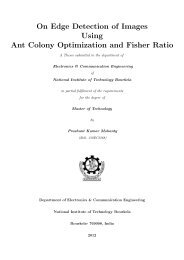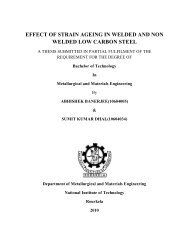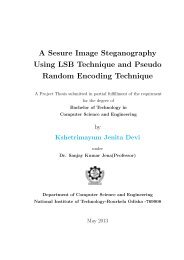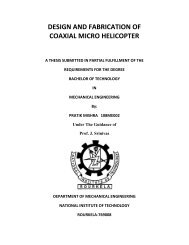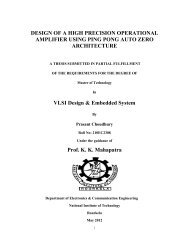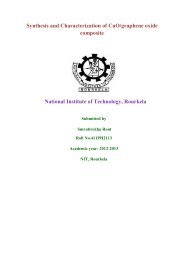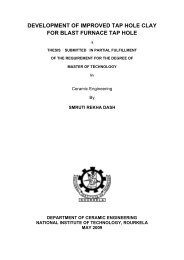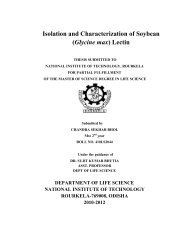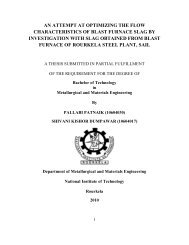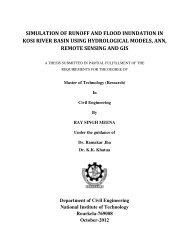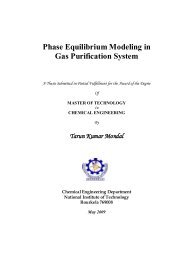Effect of hygrothermal treatment on the tensile properties - ethesis ...
Effect of hygrothermal treatment on the tensile properties - ethesis ...
Effect of hygrothermal treatment on the tensile properties - ethesis ...
You also want an ePaper? Increase the reach of your titles
YUMPU automatically turns print PDFs into web optimized ePapers that Google loves.
wood), and geotextiles. The jute composites may be used in everyday applicati<strong>on</strong>s<br />
such as lampshades, suitcases, paperweights, helmets, shower and bath units. They are<br />
also used for covers <str<strong>on</strong>g>of</str<strong>on</strong>g> electrical appliances, pipes, post-boxes, ro<str<strong>on</strong>g>of</str<strong>on</strong>g> tiles, grain<br />
storage silos, panels for partiti<strong>on</strong> & false ceilings, bio-gas c<strong>on</strong>tainers, and in <strong>the</strong><br />
c<strong>on</strong>structi<strong>on</strong> <str<strong>on</strong>g>of</str<strong>on</strong>g> low cost,<br />
mobile or pre-fabricated buildings which can be used in times <str<strong>on</strong>g>of</str<strong>on</strong>g> natural calamities<br />
such as floods, cycl<strong>on</strong>es, earthquakes, etc.<br />
2.2.4. Limitati<strong>on</strong> <str<strong>on</strong>g>of</str<strong>on</strong>g> jute fibre composites<br />
Unfortunately, all mechanical and o<strong>the</strong>r physical <strong>properties</strong> <str<strong>on</strong>g>of</str<strong>on</strong>g> natural fibres are<br />
influenced by <strong>the</strong>ir growing c<strong>on</strong>diti<strong>on</strong>s, fibre processing technique and, as for o<strong>the</strong>r<br />
fibre types, by <strong>the</strong> fineness <str<strong>on</strong>g>of</str<strong>on</strong>g> <strong>the</strong> fibre and sample test-length. Although, as with most<br />
<str<strong>on</strong>g>of</str<strong>on</strong>g> <strong>the</strong> o<strong>the</strong>r plant-based natural fibres, cellulose forms <strong>the</strong> main structural comp<strong>on</strong>ent<br />
<str<strong>on</strong>g>of</str<strong>on</strong>g> jute, <strong>the</strong> n<strong>on</strong>-cellulosic comp<strong>on</strong>ents e.g., lignin and hemicellulose, also play an<br />
important part in determining <strong>the</strong> characteristic <strong>properties</strong> <str<strong>on</strong>g>of</str<strong>on</strong>g> <strong>the</strong> fibres.<br />
There is, however, a major drawback associated with <strong>the</strong> applicati<strong>on</strong> <str<strong>on</strong>g>of</str<strong>on</strong>g> jute fibres for<br />
reinforcement <str<strong>on</strong>g>of</str<strong>on</strong>g> resin matrices. Due to presence <str<strong>on</strong>g>of</str<strong>on</strong>g> hydroxy and o<strong>the</strong>r polar groups in<br />
various c<strong>on</strong>stituents <str<strong>on</strong>g>of</str<strong>on</strong>g> jute fibre, <strong>the</strong> moisture uptake is high (approx. 12.5% at 65%<br />
relative humidity & 20 o C) by dry fibre and 14.6% by wet fibre. All this leads to (i)<br />
poor wettability with resin and (ii) weak interfacial b<strong>on</strong>ding between jute fibre and <strong>the</strong><br />
relatively more hydrophobic matrices. Envir<strong>on</strong>mental performance <str<strong>on</strong>g>of</str<strong>on</strong>g> such<br />
composites is generally poor due to delaminati<strong>on</strong> under humid c<strong>on</strong>diti<strong>on</strong>s. With<br />
increase in relative humidity upto 70%, <strong>the</strong> tenacity and Young’s modulus <str<strong>on</strong>g>of</str<strong>on</strong>g> jute<br />
increases but bey<strong>on</strong>d 70%, a decrease is observed.<br />
2.5. Polyester<br />
Cure at room or elevated temperature. It has good chemical resistance.<br />
Limitati<strong>on</strong>s:- emissi<strong>on</strong> <str<strong>on</strong>g>of</str<strong>on</strong>g> styrene, shrinkage <strong>on</strong> curing (7-10%)<br />
The term polyester covers a very large chemical family <str<strong>on</strong>g>of</str<strong>on</strong>g> which “unsaturated resins”<br />
covering orthophthalic, isophthalic, vinyl esters and blends form <strong>the</strong> largest single<br />
group <str<strong>on</strong>g>of</str<strong>on</strong>g> fibre reinforced <strong>the</strong>rmosets. They are usually manufactured by reacting<br />
toge<strong>the</strong>r dihydric alcohols (glycols) and dibasic organic acid, ei<strong>the</strong>r or both <str<strong>on</strong>g>of</str<strong>on</strong>g> which<br />
c<strong>on</strong>tain a double-b<strong>on</strong>ded pair <str<strong>on</strong>g>of</str<strong>on</strong>g> C atoms. By eliminati<strong>on</strong> <str<strong>on</strong>g>of</str<strong>on</strong>g> water between <strong>the</strong> acids<br />
and glycols, ester linkages are formed, producing a l<strong>on</strong>g chain molecule comprising<br />
14





